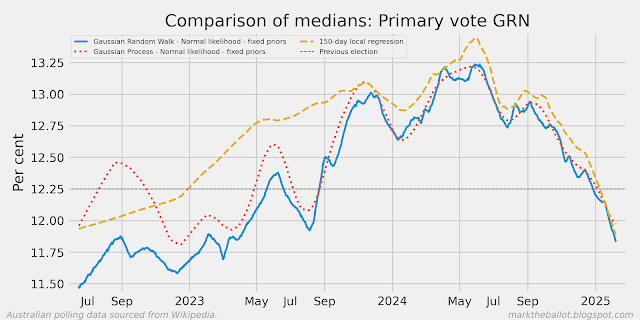Using aggregation techniques to assess how the population would vote if an election was held now, based on the the two-party preferred estimates from pollsters, Labor would win 48.8 per cent of the two party preferred vote and the Coalition would win 51.2 per cent. While this gives an advantage to the Coalition, it is likely that neither the Coalition nor Labor would win sufficient seats in their own right to form government. Both major parties would seek to negotiate with the Greens and independent members elected to Parliament, in order to form government. Note: the Gaussian Process (GP) model performs poorly at the end of the series, and I consequently give higher credence to the Gaussian Random Walk (GRW) model.
In terms of the Primary votes: Labor's primary vote is around 30.8 per cent. The Coalition is around 39.0 per cent. the Greens are around 12.0 per cent. And others are around 18.2 per cent. The Greens, Labor and Others are all down on the previous election. The Coalition's poll results are better than its performance at the last election.
| 2pp vote ALP | 2pp vote L/NP | Primary vote ALP | Primary vote GRN | Primary vote L/NP | Primary vote Other | |
|---|---|---|---|---|---|---|
| Gaussian Random Walk - Normal likelihood - fixed priors | 48.75 | 51.23 | 30.30 | 11.83 | 39.47 | 18.37 |
| Gaussian Process - Normal likelihood - fixed priors | 49.26 | 50.74 | 30.76 | 11.97 | 39.03 | 18.24 |
| 150-day local regression | 48.70 | 51.30 | 30.57 | 11.89 | 39.58 | 17.82 |
Finally, turning to the attitudinal polling, we have the following charts.




















No comments:
Post a Comment